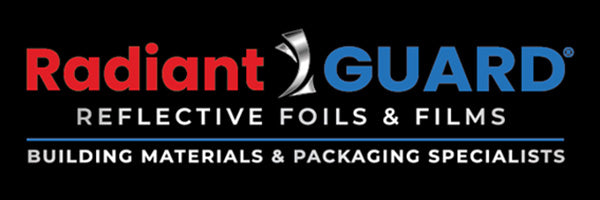A radiant barrier is a highly reflective material which significantly reduces the transfer of radiant heat either by reflecting it away from its surface OR emitting a very little amount of heat from the surface opposite the heat source offering a permanent way to control radiant heat. Radiant barriers BLOCK radiant heat energy instead of absorbing it like conventional mass insulations (fiberglass, cellulose). In addition, radiant barriers are unaffected by humidity and will continue to perform at a consistent level no matter how humid the seasonal climate, unlike conventional mass insulations, making them excellent at consistently controlling heat.
What Classifies as a Radiant Barrier
Per the Department of Energy (DOE), a product classified as a "radiant barrier" MUST have a low emittance of 10% or less and a high reflectance of 90% or more.
RadiantGUARD radiant barriers have an emittance of only 3-5% and a reflectance of 95-97%; considerable better than the DOE's radiant barrier minimum classification requirements.
RadiantGUARD Radiant Barriers
RadiantGUARD Xtreme® radiant barrier is manufactured using metalized film and is comprised of a middle layer of high strength woven fabric with a metalized film laminated to the top and bottom. A thin proprietary anticorrosive coating is added to both exterior metalized film surfaces to maintain surface reflectivity and prevent any loss of aluminum particles preventing corrosion. Xtreme feels and behaves like reflective plastic but is highly reflective and tear-resistant.
Radiant Barrier Key Concepts
Reflectivity
(emissivity) |
Per the Department of Energy (DOE), for a product to be officially classified as a "radiant barrier" it MUST have a reflectivity rating of 90% or higher and conversely, an emissivity rating of 10% or lower.
Reflectivity defines the amount of radiant heat is reflected away from the surface of the barrier facing a heat source. Emissivity defines the amount of radiant heat that radiates from the surface of the barrier and it typically measured on the surface of the barrier facing away from the heat source.
Higher reflectivity ratings result in more radiant heat being reflected.
RadiantGUARD radiant barriers have a reflectivity of 95-97% ( an emissivity of 3-5%).
|
| Durability |
To give a radiant barrier durability and strength, a middle "woven fabric" layer is placed in the center of the product.
Our radiant barrier products use a tightly woven fabric which makes it a much stronger product allowing it to hold staples and nails while not tearing or pull through.
RadiantGUARD radiant barriers are the strongest materials on the market. Compare our specifications to any other competing product's details.
|
| # of Layers |
Many consumers have been misled to believe that a radiant barrier with more layers is more effective than one with less layers. It is not the number of layers that makes one radiant barrier better than the other. Current ASTM C1313 testing results should be used to evaluate what makes one radiant barrier better than another. If a supplier doesn't have current testing available this should be considered a red flag. |
| Fire Ratings |
Radiant barriers, like most building materials, must be tested and meet specific fire ratings. The fire rating of a radiant barrier, determined by ASTM E84 fire test with optional E2599 mounting method, is determined by the flame spread and smoke development results of the surface burning characteristics test performed.
There are two organizations that provide fire ratings for building materials based on the product's flame spread and smoke development results:
- The National Fire Protection Organization (NFPO), and
- The Uniform Building Code (UBC).
NFPO's highest fire rating classification is "Class A."
UBC's highest fire rating classification is "Class 1."
NOTE: ALL building materials can burn. Fire rating tests are designed to classify how quickly building materials burn.
All RadiantGUARD product meet the highest fire ratings available, Class A / Class 1, tested either under ASTM E84 or the ASTM E-84 w/E2599 mounting method. Please review our radiant barrier specification for the actual test results.
|
Breathable
(perforated)
vs.
Vapor Barrier
(solid) |
Radiant barriers come either breathable (perforated) or non-breathable/vapor barrier (solid).
A perforated radiant barrier has small holes throughout the product that allow moisture vapor to pass through. Per ASTM C1313, the permeance of the material shall exceed five (5) perms as determined with Test Methods e96/e96M (Procedure A—Desiccant Method). RadiantGUARD Xtreme meets or exceed the minimum requirements.
A non-breathable/vapor barrier (solid) radiant barrier has no holes and serves as a vapor barrier. Per ASTM C1313, the permeance of the material shall NOT exceed one (1) perm as determined with Test Methods e96/e96M (Procedure A—Desiccant Method).
A general rule of thumb for deciding on a perforated or non-perforated radiant barrier:
- If the radiant barrier is to be installed in a closed wall cavity nearest the living space (such as a side wall or cathedral ceiling), a non-breathable/vapor barrier (solid) radiant barrier should be used.
- If the radiant barrier is to be installed in an area with air movement such as an attic or house wrap, we recommend a breathable (perforated) radiant barrier.
|
NASA
Certified |
Some companies claim their radiant barriers are "NASA certified." Although NASA was the first to embrace and use radiant barrier and reflective insulation technology, NASA does NOT certify any radiant barrier product or manufacturer.
|
Radiant Barrier Selection Guide
Need help determining which radiant barrier you need for your application? View our product selection guide to understand the purposes and best uses for our various radiant barrier products.





